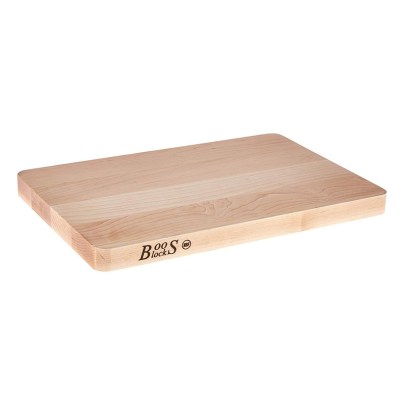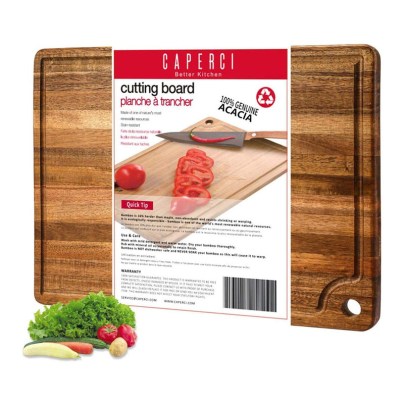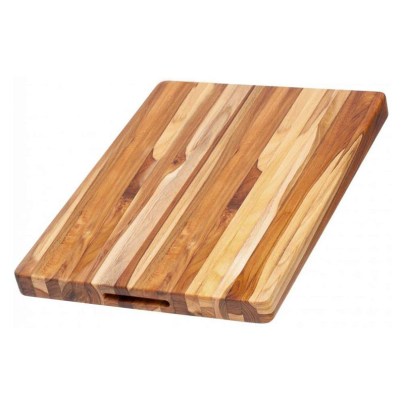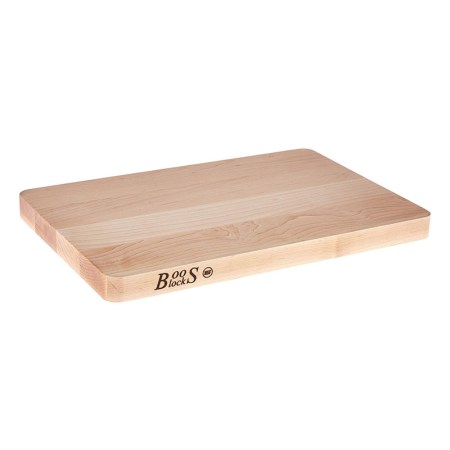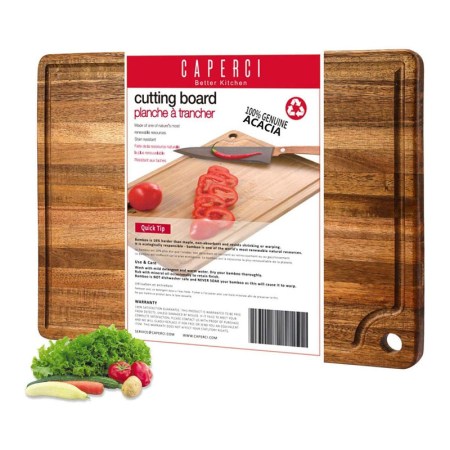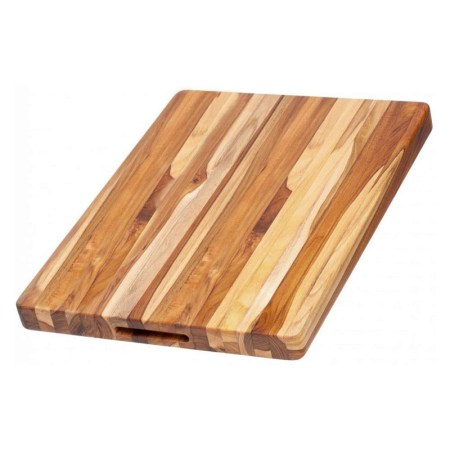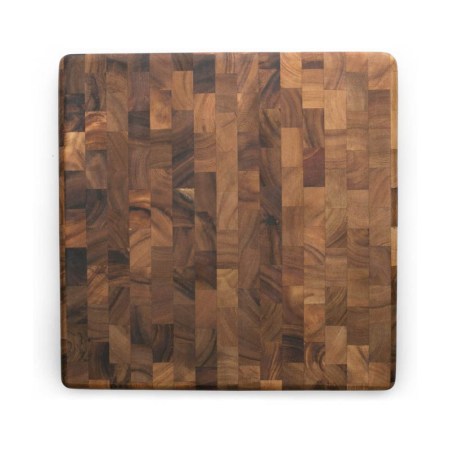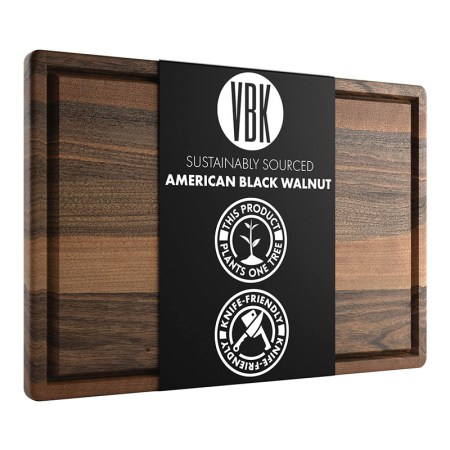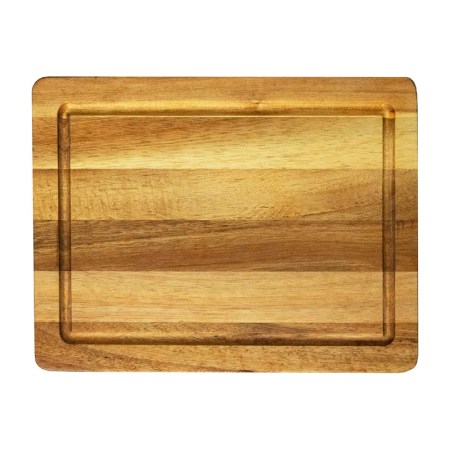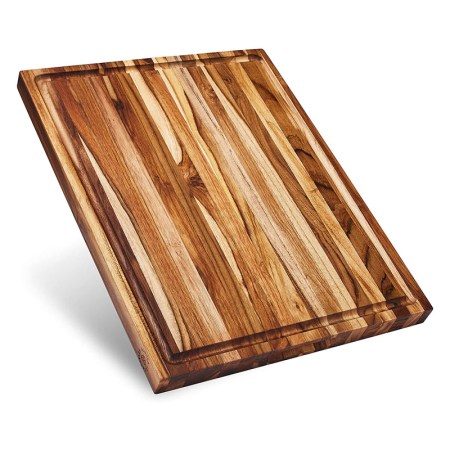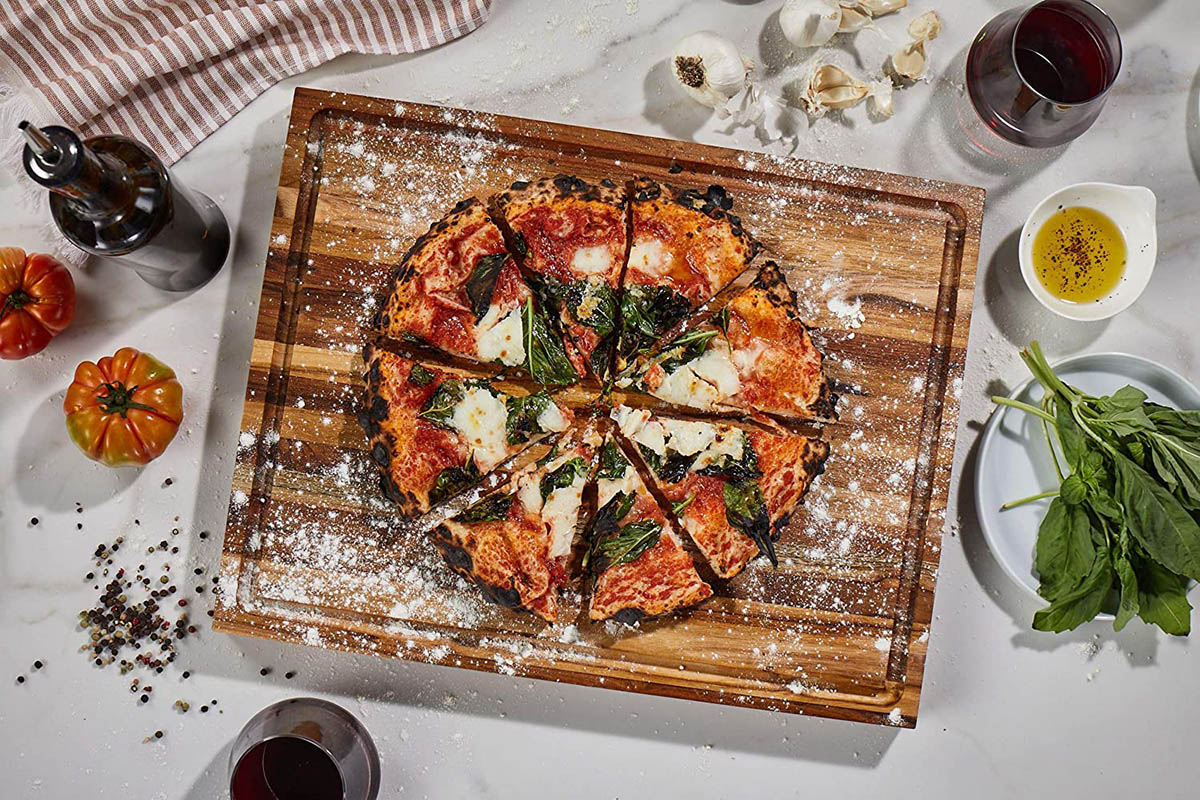
We may earn revenue from the products available on this page and participate in affiliate programs. Learn More ›
Wood cutting boards have long been popular for their durability and aesthetic, but there has been some debate about how sanitary they are. While it was believed for a time that plastic cutting boards were the safer option, many experts now argue that wood cutting boards are actually superior when it comes to avoiding cross-contamination.
When using a plastic cutting board, grooves form that quickly become a breeding ground for bacteria. Because plastic cutting boards can be quickly sanitized by washing them at high temperatures using a dishwasher, however, they’re still the superior choice for processing raw meat, unless you plan to sanitize your wood cutting board after every use.
Wood cutting boards, on the other hand, are a great choice for bread, vegetables, fruit, and cheese. They also double as attractive tableware when it comes to putting out a charcuterie board or cheese spread when entertaining.
While choosing the best wood cutting board might seem like a simple decision, there are actually a number of considerations to weigh. This guide will explore several important features to look for as you shop and then offer choices by category for some of the top products on the market.
- BEST OVERALL: John Boos Block Maple Wood Edge Grain Cutting Board
- BEST BANG FOR THE BUCK: Caperci Large Acacia Wood Cutting Board
- BEST EDGE-GRAIN: TeakHaus Edge Grain Carving Board
- BEST END-GRAIN: Ironwood Gourmet Square End Grain Chef’s Board
- BEST LARGE: Virginia Boys Kitchens Extra Large Walnut Board
- BEST SMALL: Thirteen Chefs Villa Acacia Small Wood Cutting Board
- BEST TEAK WOOD: Sonder Los Angeles, Teak Wood Cutting Board
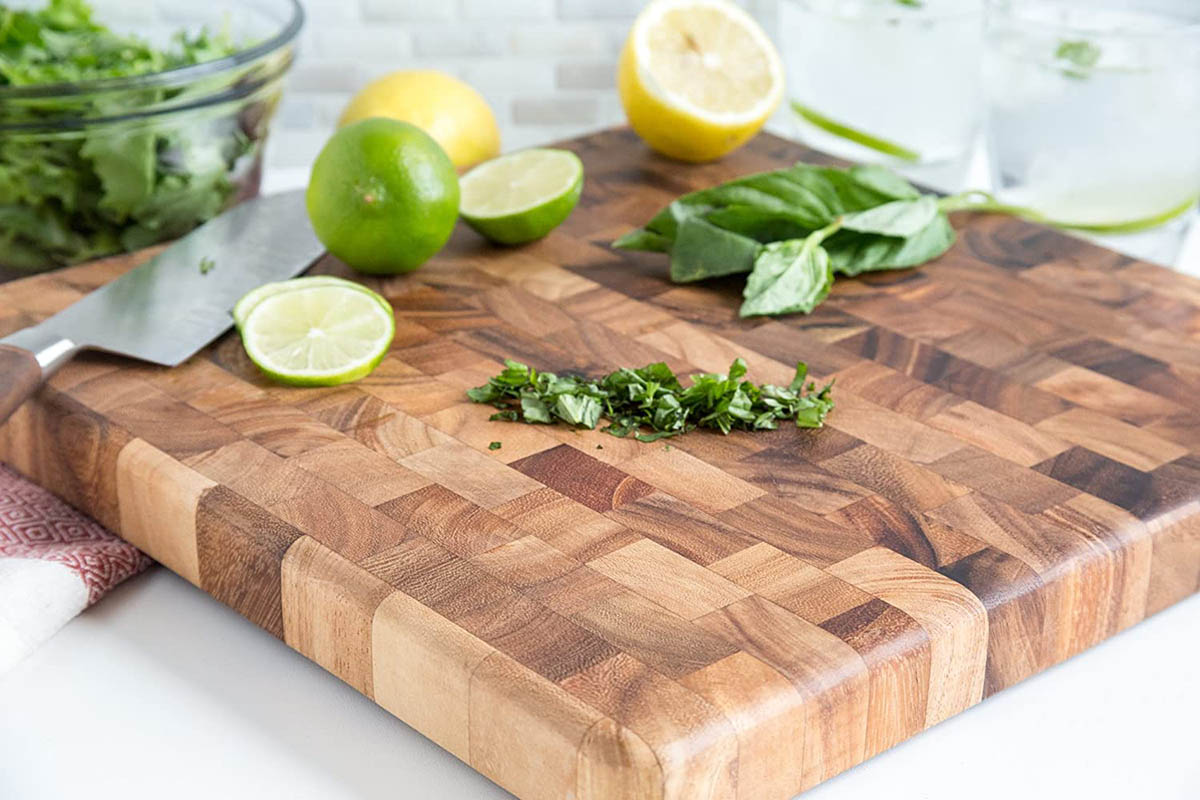
What to Consider When Choosing the Best Wood Cutting Board
While it’s easy to assume all wood cutting boards offer similar performance, a number of factors affect their functionality, including size, shape, thickness, wood type, and more. Keep reading to learn about several of the most important features to consider when choosing the best wood cutting board for your kitchen.
Size
Wood cutting boards come in a wide range of sizes, each of which has its own applications.
- Small cutting boards typically have dimensions of approximately 8 inches by 10 inches. They’re useful for minor food preparation tasks and make great serving platters for cheese, vegatables, or charcuterie.
- Medium cutting boards measure approximately 10 inches by 14 inches. They’re the most common size on the market since they don’t take up much storage space yet are versatile for many kitchen tasks.
- Large cutting boards usually measure between 12 inches by 18 inches and 15 inches by 20 inches. This size is preferred by avid home chefs who regularly chop large quantities of food.
- Extra-large cutting boards measure 20 inches by 30 inches or more. They’re a great choice for boards that are left on the countertop, though they can be somewhat difficult to clean for those without large sinks.
Shape
While most cutting boards on the market are rectangular, a variety of other shapes are also available. Rectangular cutting boards are the most popular for the majority of applications because they suit a natural chopping workflow. Square and circular boards are more well suited for serving purposes, and novelty shapes can make a fun gift.
The thickness of a cutting board is also a key consideration. Thicker cutting boards are less likely to warp over time. Also, because they’re inherently heavier, they will stay in place while you work. Look for a model that’s between 1.25 and 2 inches thick.
Edge-Grain vs. End-Grain
High-end wood cutting boards are separated into two categories: edge-grain and end-grain.
- During processing, a tree is typically cut into planks; edge-grain cutting boards are constructed using the long edges of those planks. Because the edges face upward, they have a tougher surface that may be slightly harder on knives but is more durable.
- End-grain cutting boards are made by gluing together a number of plank ends. Because the vertical wood fibers are more forgiving, these boards are preferred by chefs who want to maintain the sharpness of their knives. However, as they do have exposed ends, end-grain boards tend to dry out and crack if not properly oiled and maintained.
Wood Type
While cutting boards can be made from many types of wood, these are the best options for optimal knife maintenance, scratch resistance, and preventing the spread of bacteria. The hardness of each wood type is measured by a Janka hardness rating of pound-force (lbf). While harder woods are more scratch resistant, they can dull knives over time. Look for a wood type with a hardness rating between 1,000 and 1,800 lbf.
- Maple, at 1,450 lbf, is hard and scratch resistant with a closed grain that makes it less porous and more food-safe.
- Walnut has a naturally dark color that hides stains. A lower hardness rating of 1,010 lbf makes it the ideal pick for knife maintenance.
- Beech has a light cream color that easily stains but is extremely resistant to scratching at 1,300 lbf.
- Teak, a closed-grain, tropical hardwood, is more expensive than many other wood types. It’s resistant to warping and cracking and is also lower maintenance than many other types of wood. At 1,050 lbf, teak wood is quite soft, making it a good choice for knife maintenance.
- Acacia is one of the most durable choices for constructing cutting boards with an incredibly hard rating of 1,750 lbf.
Extra Features
Wood cutting boards may also offer a range of useful additional features.
- Rubber feet elevate the cutting board and are designed to prevent it from sliding on the countertop. Cutting boards with rubber feet, however, are not reversible.
- A hanging hole allows the board to be hung on a wall in kitchens with limited cabinet space.
- Grooved edges are designed to catch juices and other liquids, preventing them from dripping onto the countertop.
- Handles or grip holes make a cutting board easier to maneuver.
Aesthetic
While wood cutting boards are largely used for practical kitchen applications, they can also make attractive and unique rustic serving platters. While aesthetics may not be a major consideration for a cutting board that will simply be a kitchen workhorse, it’s something to keep in mind if the board will be doing double duty as a cheese, bread, vegetable, or charcuterie serving platter for a party.
Each type of wood differs in appearance, with colors, grain patterns, and finishes varying greatly from model to model. The use of end-grain or edge-grain wood also affects the look of a cutting board, with end-grain wood providing a checkerboard effect and edge-grain wood having a more traditional straight-lined aesthetic.
Our Top Picks
The best wood cutting board can serve a multitude of food preparation and serving purposes. These top picks take into account the abovementioned features as well as overall quality and price in a variety of categories to suit just about any kitchen.
Best Overall
John Boos Block Maple Wood Edge Grain Cutting Board
Edge-grain models are considered to be the gold standard, and this model from John Boos is an excellent pick. It’s made from sustainably sourced, hand-selected northern hard rock maple and is fully reversible. Due to its edge-grain construction, it’s incredibly durable.
This board measures 20 inches by 15 inches and is 1.5 inches thick. Other sizes are available, some of which have grooves for catching juices and other liquids. Like all wood cutting boards, it should be hand-washed and is not dishwasher safe. John Boos recommends oiling the board regularly, especially for users who live in dry climates.
Best Bang for the Buck
Caperci Large Acacia Wood Cutting Board
Cutting boards made from acacia tend to be affordable while maintaining a high standard of performance. This model by Caperci is large, measuring 12 inches by 18 inches, and has a groove around the edge to catch juices, making for tidier food preparation. One of the corners has a finger grip hole, allowing you to easily hold the cutting board in place. The hole also makes it possible to hang the board for storage.
The wood is not dyed or stained and is certified by the Forest Stewardship Council, ensuring that sustainable practices were used in production. Before using this board for the first time, make sure to rub down the surface with food-grade mineral oil. This board should be hand-washed and should not be submerged in water.
Best Edge-Grain
TeakHaus Edge Grain Carving Board
Edge-grain cutting boards are preferred by many because of their durability, and this model by TeakHaus is a great example. It’s made from teak wood, which has long been favored for its ability to resist moisture damage. It’s also resistant to shrinking, meaning the wood is less likely to warp over time. The wood was sourced responsibly and is certified by the Forest Stewardship Council.
This board is large, measuring 15 inches by 20 inches with a thickness of 1.5 inches. It’s also heavy, at 12 pounds, meaning it will stay in place while you’re chopping but may be difficult to maneuver for cleaning. It does, however, have slots on either end to make it easier to lift. The board should be hand-washed and oiled occasionally for optimal longevity.
Best End-Grain
Ironwood Gourmet Square End Grain Chef’s Board
This model from Ironwood Gourmet is made from acacia and measures 14 inches by 14 inches by 1.25 inches. It’s specifically designed to lessen the wear and tear on knives and other utensils, due to its use of end-grain wood. The natural oils of the acacia wood make this board water resistant and help to prevent the spread of bacteria.
The end-grains of the acacia wood are highly contrasting and provide a unique aesthetic that makes this board a great choice for use as tableware. This board cannot go in the dishwasher. It should be washed by hand, air-dried, and oiled regularly.
Best Large
Virginia Boys Kitchens Extra Large Walnut Board
For carving a Thanksgiving turkey or other substantial roast, an extra-large cutting board is a useful addition to your kitchen. It’s just as handy for prepping a high volume of vegetables. Measuring 18 inches by 24 inches, this model from Virginia Boys Kitchens is up to the task. Because of its 8.8 pound size, it’s also weighty.
This board is made from sustainably sourced American black walnut and is preseasoned for added convenience, allowing you to use it right away. The seasoning is done with pure fractionated coconut oil, so there are no harmful chemicals used in the process. It’s designed with a juice groove around the edge that is useful for protecting your countertops. The dark hue of the walnut makes for a striking presentation when used as a serving tray.
Best Small
Thirteen Chefs Villa Acacia Small Wood Cutting Board
While large cutting boards are essential for many kitchen tasks, you don’t always want to go through the effort of cleaning one when you just need to cut up an apple or slice a lemon in half. This small board measures 9 inches by 12 inches, which is large enough to be useful but not so big that it’s a hassle to clean. At 2 pounds, it’s lightweight and easy to maneuver around the kitchen. This board has a groove around the edge, but a grooveless version is also available.
This board is made from acacia and must be hand-washed and oiled regularly. The brand production is certified by the Forestry Stewardship Council.
Best Teak Wood
Sonder Los Angeles, Teak Wood Cutting Board
While cutting boards are constructed from a wide variety of different types of wood, teak is preferred by many experts because it’s easy to maintain and fares well when exposed to moisture. This model by Sonder Los Angeles measures 14 inches by 18 inches and is 1.25 inches thick, making it a good size for most kitchen tasks. It weighs 9 pounds, so it will stay in place while you use it, but it may prove too heavy for some users to wash easily.
While one side is flat, the other has a deep juice groove, allowing it to hold up to 3.5 ounces of liquid. Each end features a handle to make the board easier to maneuver. It’s made with edge-grain teak wood and is preseasoned with mineral oil for added convenience.
FAQs About Wood Cutting Boards
Check out these answers to some of the most frequently asked questions about wood cutting boards.
Q. What woods are not good for cutting boards?
Avoid cutting boards made from softwoods, like pine, and open-pored woods, like ash and red oak.
Q. Are wooden cutting boards sanitary?
Plastic cutting boards are the most sanitary option for processing raw meat because they can be sanitized at high temperatures in the dishwasher. Wooden cutting boards are the best option for cutting fruit, vegetables, and bread.
Q. How do you clean wooden cutting boards?
Always wash wooden cutting boards by hand rather than in the dishwasher. While warm, soapy water is sufficient for cleaning a cutting board used for preparing fruit, vegetables, or bread, apply a sanitizer if the board has processed raw meat.
Q. What do you oil a cutting board with?
Oil a cutting board with either a specially formulated cutting board oil or simple food-grade mineral oil.
Q. How often should I oil my cutting board?
It’s best to oil a cutting board once every 6 months.
